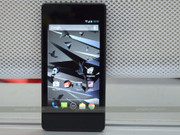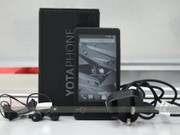Dileep Kumar
Member
- Joined
- 8 Jul 2013
- Messages
- 2,001
- Reaction score
- 481


→ While smartphones these days are stuffed to gills with powerful technology, design-wise, it would not be far-fetched to state that companies are unwilling to push the boundaries and actually take a risk, though recent launches like Blackberry Passport( Review| Pictures) and Lenovo Vibe X2( Review| Pictures) have managed to buck that trend.
Another exception that particularly caught our fancy is the YotaPhone made by a Russian broadband service provider Yota Devices.
The YotaPhone has what the company claims, "The world's first dual-screen smartphone with an always-on display." We are definitely intrigued by the ingenuity of this particular device to the point that we were left wondering why couldn't someone else think of this before!
Before we get to the review, do bear in mind that this is the first version of the YotaPhone that the company unveiled at CES 2012. In India, the YotaPhone is being sold by Jumbo Electronics exclusively via Flipkart. It's also worth noting that Yota Devices has already unveiled the next iteration of the YotaPhone, which will be unsurprisingly called YotaPhone 2, and it is all set for a December launch in London. Obviously, the YotaPhon e 2betters it predecessors in a lot of ways and we will try to get hands on one when it is launched here.
But until then, lets find out if the first generation YotaPhone still has the chops to create a stir in India.Dual Displays
The main display on the YotaPhone is 4.3-inch primary screen IPS LCD panel with a resolution of 720x1280, which is really good because it translates to a pixel density of 342ppi. It is a very crisp display with a good amount of saturation but we noticed that the whites had a very warm tone to the extent that the screen looked really yellow. The viewing angles were great and the sunlight legibility was really good too. All in all, we really liked this display.
The highlight of the device is of course the rear 4.3-inch e-ink panel has a display resolution of 360x640 pixels, which translates to a pixel density of 170ppi. In comparison, the cheapest Amazon Kindle's screen has a pixel density of 167ppi. This screen displays 16-grayscale colours just like the display on the Kindle. We checked both the screens together and noticed that the Kindle's screen was only slightly sharper but the YotaPhone screen still gets the work done.
We had no problem in sifting through the pages of H.G.Wells' classic novel Time Machine thanks primarily to the fact that an e-ink display is the only technology at the moment that comes close to emulating the characteristics of real paper. The additional benefit is that, despite being an always-on display, it actually consumes less power than an LCD screen which in turn can help save battery life. Our Amazon Kindlereview talks about the e-ink displays in general and in more detail.
Apps need to be updated to utilise this additional display for things other than notifications, which are handled by the system software. More on this later in this review.
Specifications and camera
According to YotaPhone's official website and Flipkart's online listing of the phone it is supposed to be packing a Qualcomm SoC which is a combination of a dual-core Snapdragon 400 chipset clocked at 1.7GHz with Adreno 320 GPU. We generally use a software called CPU-Z to double-check the specifications and quite surprisingly it showed that the phone is actually using a Qualcomm Snapdragon S4 Plus clocked at 1.73GHz. The model number it showed was QCT MSM8960 CDP. Incidentally, Yota Devices used the Snapdragon S4 Plus in the initial build of the YotaPhone. Also interestingly, Qualcom m'sofficial website states that Snapdragon 400 chipsets can be paired with GPU's only up to Adreno 306.
Therefore, the inclusion of Adreno 320 also makes the situation slightly murky. We got a confirmation from Jumbo Electronics that the phone uses the MSM8960 chip but the company categorically stated that it is running Snapdragon 400. In any case, we have benchmark numbers for our readers in the performance section and are awaiting an official response from Qualcomm. We will update the review accordingly as and when we hear from them
Read More:-http://m.gadgets.ndtv.com/mobiles/reviews/yota-devices-yotaphone-review-its-different-623949?pfrom=home-gadgetstop
